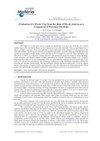环保轻骨料对地聚合物混凝土力学性能和耐久性的影响
IF 1.2
4区 材料科学
Q4 MATERIALS SCIENCE, MULTIDISCIPLINARY
引用次数: 0
摘要
本研究是在M20级地聚合物混凝土中分别以20%、40%、60%、80%和100%的重量取代天然粗骨料。不同混合料的地聚合物混凝土经受新鲜、硬化和耐久性试验。热灰骨料的使用可使地聚合物混凝土的坍落度和抗压强度分别提高约15%和9%。使用100%轻质膨胀粘土骨料(LECA),地聚合物混凝土的坍落度和抗压强度分别降低30%和38%左右。使用热灰骨料和轻质膨胀粘土骨料可使地聚合物混凝土的密度分别降低约9%和28%。热灰骨料可使地聚合物混凝土密度降低至1850 kg/m3,强度提高至24.50 N/mm2;轻质膨胀粘土骨料可使地聚合物混凝土密度大幅降低至1250 kg/m3,强度大幅降低至14 N/mm2。其他力学试验结果也显示出与压缩试验结果相似的变化。为保证GPC、TM5、LM2配合料轻质地聚合物混凝土的耐久性,进行了耐酸、耐硫酸盐、耐盐、吸水、加速腐蚀、吸附性等试验。本文章由计算机程序翻译,如有差异,请以英文原文为准。
Influence of eco-friendly lightweight aggregates in mechanical and durability properties of geopolymer concrete
This research is to replace natural coarse aggregate as 20%, 40%, 60%, 80%, and 100% respectively, by weight in an M20 grade geopolymer concrete. The geopolymer concrete with different mixes is subjected to fresh, hardened, and durability tests. Utilization of thermal ash aggregates increased the slump and compressive strength of geopolymer concrete by about 15% and 9% respectively. Whereas the slump and compressive strength of geopolymer concrete decreased by about 30% and 38% respectively by using 100% Lightweight Expanded Clay Aggregate (LECA). Density reduction in geopolymer concrete was found by using both thermal ash aggregate and lightweight expanded clay aggregate for about 9% and 28% respectively. Thermal ash aggregate decreased the density of geopolymer concrete up to 1850 kg/m3 and improved the strength up to 24.50 N/mm2, on the other side using lightweight expanded clay aggregate, the density of geopolymer concrete drastically decreased up to 1250 kg/m3 with a huge decrease in strength up to 14 N/mm2. Other mechanical test results showed similar variations with respect to the compression test results. To ensure the durability of lightweight geopolymer concrete for mixes of GPC, TM5, and LM2 conducted tests like acid resistance, sulphate resistance, salt resistance, water absorption, accelerated corrosion, and sorptivity test.
求助全文
通过发布文献求助,成功后即可免费获取论文全文。
去求助
来源期刊

Materia-rio De Janeiro
MATERIALS SCIENCE, MULTIDISCIPLINARY-
CiteScore
1.00
自引率
25.00%
发文量
51
审稿时长
6 weeks
期刊介绍:
All the articles are submitted to a careful peer-reviewing evaluation process by the journal''s Editorial Board. The Editorial Board, reviewers and authors make use of a web based proprietary automated tool to deal with the reviewing procedures.the Revista Matéria''s article reviewing restricted access system - SEER. Authors are not informed about the identity of the reviewers.
 求助内容:
求助内容: 应助结果提醒方式:
应助结果提醒方式:


